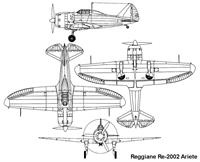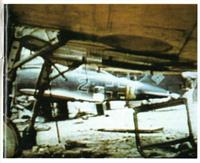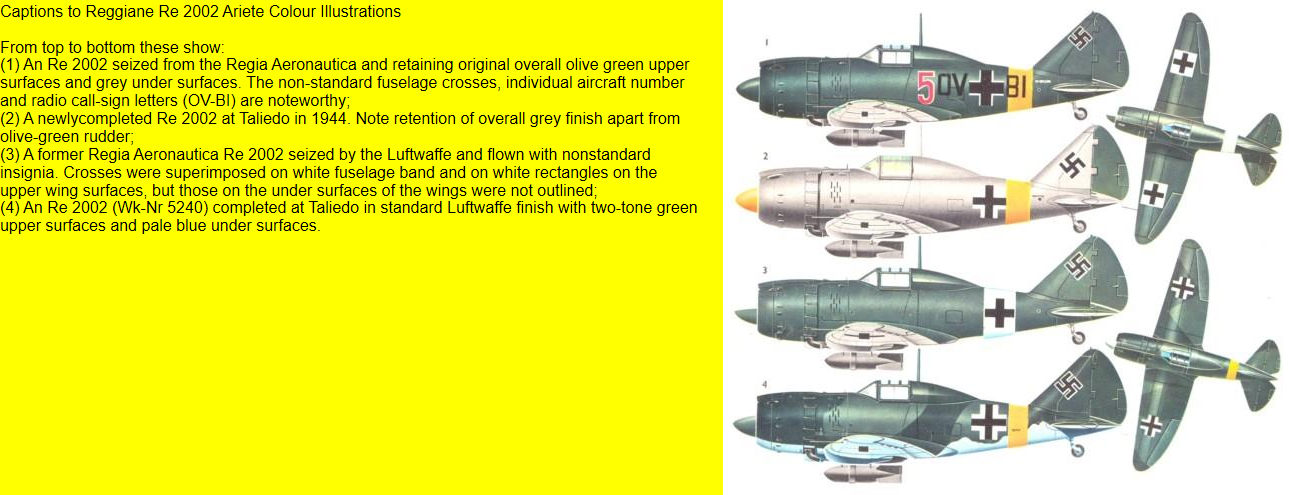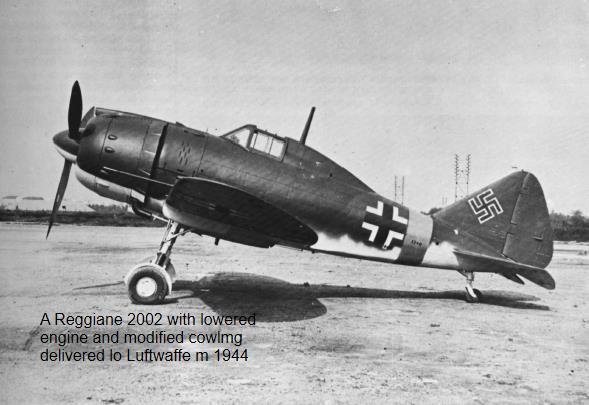


Source: Flying Review International Oct. 1967
On March 11, 1943, the Ministero dell' Aeronautica had supplemented earlier orders totalling 400 machines with an order for a further 300 Ariete IIs, although at the time of the Armistice only 147 machines (99 Serie I' and 48 Serie II') had been delivered to the Regia Aeronautica and these against the initial order for 200 aircraft. The remaining 53 aircraft on this order were nearing completion on the assembly line at Reggio Emilia, and the German authorities immediately ordered "Reggiane" to complete these, together with a further 30 aircraft of which construction had started against the third order (the second awarded the Reggio Emilia plant). Furthermore, the factory was instructed to commence immediate preparations for the production of an initial quantity of 300 examples of a new version of the Ariete II mounting a BMW 801 engine and reverting to the original fivespar wing with integral fuel tankage of the Re.2000.
The factory personnel protested that they were unable to produce such wings as they possessed no suitable sealing materials, but the Germans overruled these objections, saying that the necessary materials would be obtained from Sweden. Design of a suitable mounting to adapt the BMW 801 for installation in the Ariete II was completed rapidly, and a prototype mount was constructed in the experimental shop and transported to Germany where presumably a trial installation was to have been made in an Ariete II airframe. However, Allied attacks on Reggio Emilia put paid to all plans to manufacture the BMW 801-powered Ariete II, and also seriously affected completion of the aircraft already on the assembly line. In fact, only two were handed over to the Luftwaffe in November followed by a further six in December, and an Allied attack on the night of January 7-8, 1944 terminated production once and for all. What machinery and tooling could be salvaged from the Reggio Emilia plant was then transferred to Caproni's Taliedo factory and to another facility at Biella where tooling had already begun for 70 of the Ariete lls of the 300 that had been ordered by the Italian Ministero in March 1943. In the event, only two aircraft were completed at Biella, and of 60 built at Taliedo during 1944, only 25 reached the Luftwaffe.
The Ariete II attack fighters taken over by the Luftwaffe at the time of the Italian Armistice and those delivered subsequently were delivered to hastily-formed Schlachtgruppen in France for operations against the increasingly troublesome French resistance forces, particularly in the areas of Aisne, Vercors and Limoges, some operating from the airfield at Etampes-Mondesir.





Owing to the scarce availability of the DB 601 engines, the Reggiane company designed another development of the Re 2001 fighter range, the Re 2002, replacing the Piaggio P XI RC40 engine (1000 hp) of the Re 2000 with the more powerful Piaggio P XIX RC45 developing 1185 hp. The prototype MM 454 was completed fitting the new powerplant to the airframe of the Re 2000 and was first flown in October 1940, just after the Re 2000 which flew in July of the same year.
The first Re 2002. with the same landing gear and the transparent canopy of the Re 2000. showed soon its brilliant qualities but its development was long and a difficult one but it was also clear that, when all the defeats of the P. XIX were solved the new aeroplane with its better armament and the minor vulnerability, could de useful used as fighter- bomber and was therefore fitted with wing and ventral fuselage attachments for bomb loading.
The first series production machine (MM 7309) was delivered to Regia Aeronautica in March 1942 but the production was considerably delayed for the late deliveries of the Piaggio engines.
The second Re 2002 (MM 7310) was delivered in June 1942 and the 239' Squad, handed over the third one in January 1943: at the end of March 1943 the 102° Gruppo (209' and 239' Squad.) had in service only 19 aircraft.
The latest modifications were introducedby Reggiane in May after a couple of months of training missions (see Aerofan4/79).
In the afternoon of 10 July 1943 onCrotone airfield, the 5° Stormo Tuffatoriand namely a formation of 102° Gruppooperated for the first time with the Re 2002. On September 8 1943 149 Re 2002 have been delivered both to 101 ° Gruppo and 159° Gruppo, respectively based at Manduria and Lonate Pozzolo. In the meantime the Reggiane introduced various modifications to improve the performance of the machine. The engine and its cooling were lowered to improve the forward visibility, thus eliminating the consistent swelling of the previous top air intake. Some other modifications were made to improve the use of large bombs and the special torpedoss at the time in development phase; these consisted in a new lenghtening tail landing gear and a reenforcement of the main landing gear. All the modifications were included in the series of the Re 2002 delivered to Luftwaffe units but were retrofitted also on the first two series of Regia Aeronautica.
The Italian co-belligerant air force used about 40 Re 2002 while the Germans had about 70.

| Type |
Single seat fighter |
| Engine |
1 Piaggio P.XIX R.C.45 Turbine wih 3-bladed Piaggio constant-speed propeller |
| Dimensions |
Length 8,16 m, height 3,15 m, span 11,0 m, wing area 20,4 m2, wing profile N-38 |
| Weights |
Empty 2390 kg, loaded , max. take off weight 3240 kg |
| Performance |
Max. speed 530 km/h at 5500 m, cruising speed 400 km/h at 4500 m, stall speed 120 km/h, range 1100 km, service ceiling 11000 m, climb to 6000 m 8 min. 48 sec. |
| Armament |
2 12,7 mm Breda-SAFAT machine guns, 2 7,7 mm Breda-SAFAT machine guns, bombload 650 kg at 3 hardpoints |








